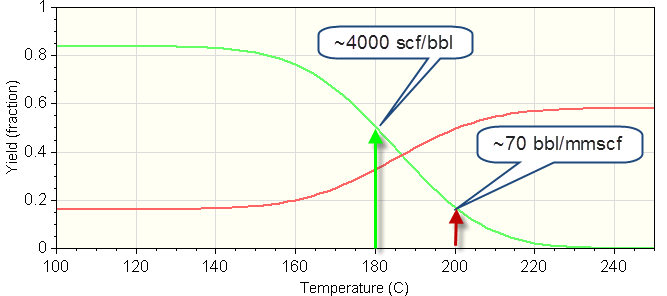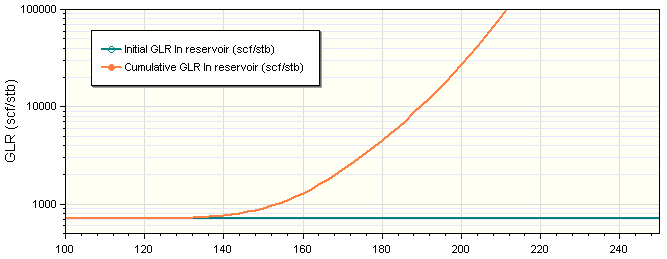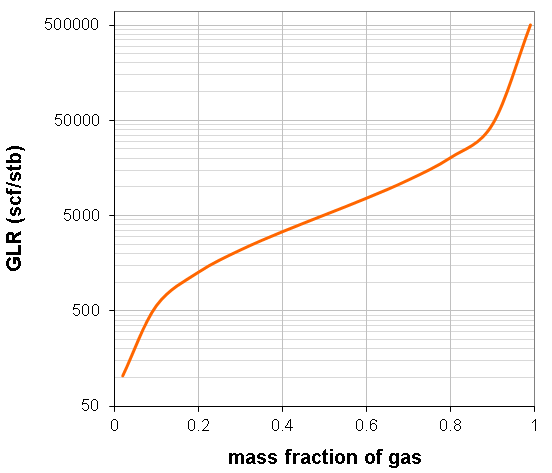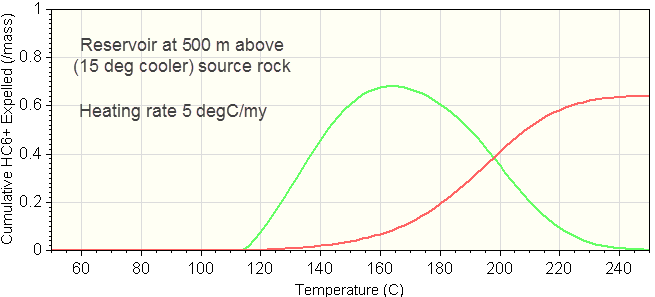| Risk Associated with Cracking of Oil in Reservoirs |
| Kinex main page | Basic concepts | Simple tutorial | Shale Play Example | FAQ | What Is New? |
Introduction
Cracking is not as well understood as primary HC generation in terms of kinetics. Mostly because we do not have as much natural data to calibrate to, as reservoirs subjected to significant cracking are not very common. The common wisdom is that reservoired oil would start to crack to gas beginning at about 165 °C, and at 185 °C most of the oil would have cracked to gas and condensate. The risk of cracking is pretty low if the reservoir temperature is less than 160 °C. The degree of cracking will depend on heating rate, ie, how long the reservoir has been at that temperature. Younger reservoirs will have lower degree of cracking.
If you know the reservoir temperature and heating rate, it is pretty easy to look at cracking risk with Kinex. Lets say that your reservoir is currently at 180 °C and the reservoir age is Oligocene. Let's say the age of the reservoir is about 30 million years old, and surface temperature is about 20 °C. The heating rate is approximately (180-20)/30, i.e. about 5 °C/my, assuming the basin subsidence rate is pretty constant. We put the heating rate in Kinex and drag the marine source rock into the source window, check "In reservoir cracking at the bottom of the window and click Calculate. We will see this diagram.

In version 5.81, the GLR plots would show the cumulative GLR in the reservoir and the initial GLR you provided via your GOGI input:


Uncertainties
There is a lot of things we are not sure yet. The published kinetics may be a good starting point. Not all oils would have the same cracking kinetics. We typically don't know what kind of oil may be in the prospect reservoir. We may be off on our prediction of temperature in the reservoir by 10 °C easily. The most appropriate thing to do is do some scenario testing and get a range of answers.Some observations show that waxy oil from lacustrine, or oil prone coally source rocks may be harder to crack. Older reservoirs, such as the Jurassic reservoirs in the North Sea, we have mostly gas condensate fluids at about 180 °C. In Younger reservoirs, or although the reservoir age may be older, but it is buried quickly recently, these is lower risk for cracking. The Jeruk field (Oligocene reservoir) in Indonesia is currently at 183 °C and it is still an low API (<35 API) and low GOR (<500 scf/bbl) oil.
Another method
You may also try the "Coupled source and reservoir" option. This allows you to model the source rock and reservoir using the same heating rate. The reservoir can be inside of the source rock, or that it may be directly above the source rock, therefore having same heating rate but with different temperatures.The following example uses 5 °C/my heating rate, with the "Coupled source and reservoir" option, and the reservoir temperature is 15 °C cooler than the source rock (~500 meters above). The temperature difference between the reservoir and source is entered in the Cracking parameters page of the Rock and fluid options dialog. The curves show the generation process, as well as cracking in the reservoir. This assumes that the oil migrates into the reservoir instantaneously.

References:
- Pepper, A. S., 1991, Estimating the petroleum expulsion behavior of source rocks: a novel quantitative approach: in W. A. England, and A. J. Fleet, ed., Petroleum migration: The Geological Society Special Publication 59: London, p.9-31.
- Pepper, A. S., and P. J. Corvi, 1995, Simple kinetic models of petroleum formation. Part I: oil and gas generation from kerogen : Marine and Petroleum Geology, v. 12, p.291-319.
- Pepper, A. S., and T. A. Dodd, 1995, Simple kinetic models of petroleum formation. Part II: oil-gas cracking : Marine and Petroleum Geology, v. 12, p.321-340.
- Pepper, A. S., and P. J. Corvi, 1995, Simple kinetic models of petroleum formation. Part III: Modelling an open system : Marine and Petroleum Geology, v. 12, p.417-452.
©2001-2015, ZetaWare, Inc. All rights reserved